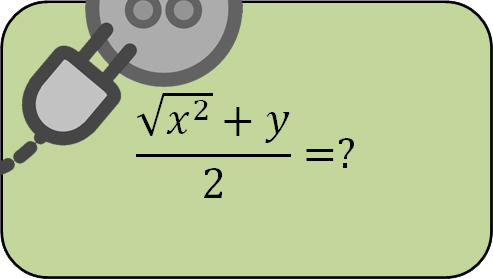
Have you been studying your SAT vocabulary? What is muscle atrophy? If that caught you off guard, try studying more often from the vocab provided in my previous article.
Algebra is not the easiest thing to do, especially when there are several variables thrown in the mix. Plugging in is a technique to reduce complex algebraic expressions into real, tangible numeric values. Take, for example, the following problem.
- If a and b are positive integers such that a + b = 12, then what is the value of b-12⁄6a?
- (A) –5⁄2
- (B) –5⁄4
- (C) 1⁄6
- (D) –1⁄6
- (E) 6
The crux of this strategy, as the name implies, is to make up numbers that fit the constraints of the problem and just plug them in. First, ask yourself,
| What are the restrictions of the problem? |
That’s easy enough, a and b must be two positive integers that add to 12. Next,
| Pick numbers that satisfy these restrictions. |
Let’s choose 4 for a and 8 for b. These numbers will work because the sum of them adds up to 12 and they are both positive. Finally,
| Plug them in and compare your result with the answer choices. |
b-12⁄6a = (8)-12⁄6(4) = -4⁄24 = –1⁄6
Yielding our final answer, choice (D), –1⁄6. Let’s try another problem.
- An integer x is multiplied by 9, and the result is decreased by 15. This result is divided by 3. Finally, the result is increased by 7. In terms of x, what is the final result?
- (A) x + 2
- (B) x – 2
- (C) 3x + 2
- (D) 2x + 3
- (E) 5x – 2
First we ask ourselves, what are the restrictions? Well, x must be an integer. So let’s just choose a number. How about 2? Let’s plug in! 2 multiplied by 9 is 18. 18 decreased by 15 is 3. 3 divided by 3 is 1 and adding 7 to 1 we get 8. Now go to the answer choices and see which expressions evaluate to 8.
- (A) Gives us (2) + 2 = 4, which isn’t 8, we can cross this out
- (B) Gives us (2) – 2 = 0, we can cross this out
- (C) Gives us 3(2) + 2 = 6 + 2 = 8, this looks like the right answer, but just in case…
- (D) Gives us 2(2) + 3 = 4 + 3 = 7, we can cross this out
- (E) Gives us 5(2) – 2 = 10 – 2 = 8, wait, two right answers!?
If you work out the math, you are left with two answer choices that both come out to 8, C and E.
Do not panic just yet – this situation could happen on the actual SAT.
| Two or more remaining answers just means you need to pick new numbers. |
So how about 3 as x? 3 multiplied by 9 is 27. 27 decreased by 15 is 12. 12 divided by 3 is 4. Adding 7 to 4 we get 11. If you plug in 3 for x, only C now correctly yields 11, whereas E gives 13. That means answer choice (C) is correct.
Now there are three important things to know about plugging in.
First and foremost, this technique can only be applied to problems that have algebraic expressions in them which can be evaluated by plugging in numbers. Make sure when you do this, always follow the restrictions of the problem and the laws of mathematics. Choosing 200 degrees as a value for the obtuse angle of a triangle may seem appealing, but this violates the rule that a triangle must have 180 degrees!
Secondly, when plugging in, you may encounter a problem where two or more answers equal the numerical value from this technique (such is the case with practice problem 2 above). In this scenario, choose another set of numbers that satisfy the restrictions of the problem and keep plugging in again until you can eliminate all but one answer choice. That will be the correct answer.
Lastly, each one of these problems can be solved with pure algebra. If you believe you are skilled enough, feel free to solve them as they were “intended.” However, I strongly urge you to try at least 20 practice math problems and attempt to use plugging in before deciding that you prefer to use algebra directly. Plugging in practice can be found here and here. Below are the algebraic solutions to the problems.
- If a and b are positive integers such that a + b = 12, then what is the value of b-12⁄6a?
- (A) –5⁄2
- (B) –5⁄4
- (C) 1⁄6
- (D) –1⁄6
- (E) 6
a + b = 12, therefore, b = 12 – a. Substituting in for b, we get b-12⁄6a = (12-a)-12⁄6a = -a⁄6a = –1⁄6
- An integer x is multiplied by 9, and the result is decreased by 15. This result is divided by 3. Finally, the result is increased by 7. In terms of x, what is the final result?
- (A) x + 2
- (B) x – 2
- (C) 3x + 2
- (D) 2x + 3
- (E) 5x – 2
x multiplied by 9 is 9x. Decreasing this result by 15 is 9x-15, and dividing this by 3 yields 9x-15⁄3 = 3x – 5. Adding 7 to this gives us the final answer 3x – 5 + 7 = 3x + 2.
Finally, I will leave you with this problem. It can be solved with plugging in, so try it out for homework; the solution will be included in next week’s article. Don’t forget to keep on studying your vocab!
- If x and y are positive integers such that x – y = 3, then what is the value of xy+7y+3x+21⁄xy+10x?
- (A) 7⁄2
- (B) 1
- (C) 6
- (D) 1⁄3
- (E) 1⁄4

